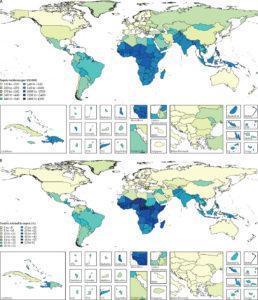
Age-standardised sepsis (A) incidence per 100 000 population for both sexes, in 2017, and (B) percentage of all deaths related to sepsis, age-standardised for both sexes, in 2017
ATG=Antigua and Barbuda. FSM=Federated States of Micronesia. LCA=Saint Lucia. TLS=Timor-Leste. TTO=Trinidad and Tobago. VCT=Saint Vincent and the Grenadines (Rudd et al., 2020 Lancet)
Sepsis is life-threatening organ dysfunction due to a dysregulated host response to infection (Singer et al., 2016). Sepsis is actually recognised as a major global health problem, and the World Health Assembly has urged member states to strengthen efforts to identify, document, prevent, and treat sepsis (1). Although few estimates of the global incidence of sepsis or mortality from this disorder exist. Current data underestimate the prevalence, which has been extrapolated from data on adults only with sepsis treated in hospital, in high-income countries and using different case definitions.
For this study Rudd et al., used a new extensive methodology that assessed the global, regional, and national incidence of sepsis and mortality between from 1990 and 2017, including 195 locations, 282 underlaying causes and all ages. Researchers estimated the burden of sepsis in 2017 was 48·9 million [95% uncertainty interval 38·9–62·9] incident cases and 11·0 million [10·1–12·0] deaths worldwide), this is more than double previous global findings (incident cases 48.9 vs19.4M/ deaths 11vs 5.3M )
They highlighted that the global burden of sepsis is larger than previously appreciated, requiring urgent attention. In addition, there is substantial variation in sepsis incidence and mortality according to lowest socio-demographic index, with the highest burden in locations that are least equipped to prevent, identify, or treat sepsis such as Sub-saharan Africa. Emphasing the need for greater effort for prevention and treatments in these regions. These findings tell as that is it time to focus in sepsis, mainly in Africa, at all levels of prevention mainly but also research that aims to find next next generation treatment.
Sepsis is wanted in Africa !
Journal article : Rudd et al. 2020 . Global, regional, and national sepsis incidence and mortality, 1990–2017: analysis for the Global Burden of Disease Study. The Lancet Vol 395 January 18, 202
Article by Mouna Ben Azaiz
References:
- Service delivery and safety: improving the prevention, diagnosis and clinical management of sepsis. May, 2017. https://www.who.int/servicedeliverysafety/areas/sepsis/en/ (accessed Nov 6, 2019).)
